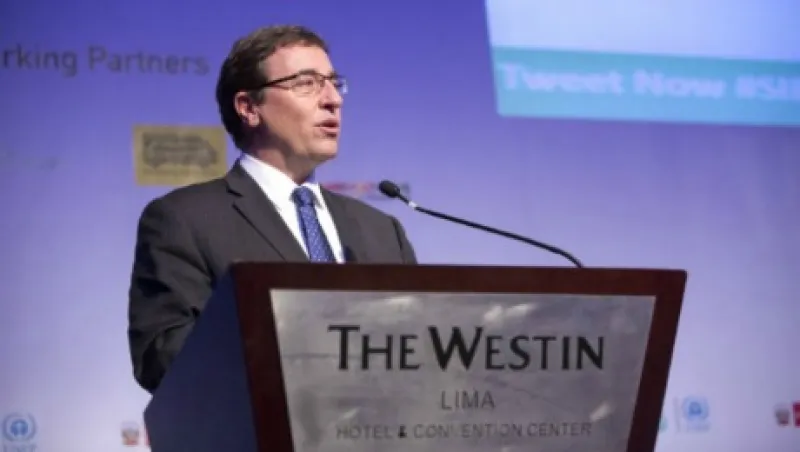When close to 50,000 assorted policymakers, politicians, economists and campaigners descend on the bosky Paris suburb of Le Bourget on Monday, there will be many who come more in hope than expectation. The Conference of the Parties, comprised of more than 190 nations and the European Union, historically has been an unwieldy, slow-moving beast. Charged with overseeing the United Nations Framework Convention on Climate Change, the COP’s successes have been limited to date, given that it is an organization that relies on wide-scale multilateralism in an arena in which dissent and self-interest are the norm. And yet Paris, which marks the 21st meeting of the parties — nearly two decades since the adoption of the Kyoto Protocol to reduce greenhouse gas emissions — could be the game changer.
There are a number of causes for optimism as we approach the conference, with indications that Paris could see the signing of a legally binding accord limiting temperature rises to less than 2 degrees Celsius. If accomplished, an accord would represent a negotiating breakthrough to a climate change stalemate dating back to the Montreal Protocol of 1987. Whereas the COP has shown a marked ability to turn initial goodwill into rancorous disharmony — COP15 in Copenhagen in 2009 springs to mind — the run-up to COP21 reveals an encouraging pattern of environmental policy announcements and national commitments. In recent years more than 150 countries have issued climate action plans to reduce their carbon intensity, with a concomitant groundswell in public opinion. Investors have followed suit, with a loose coalition of institutions and individuals representing $2.6 trillion in assets taking the first steps to decarbonize their portfolios.
One much-discussed — often frustratingly intransigent — subject that ought to be high on the list of action points for the Paris COP is carbon emissions trading, particularly the fate of the EU Emissions Trading System. The EU ETS is the scheme by which greenhouse gas allowances are traded between emitting entities in Europe. The scheme covers more than 11,000 power stations and industrial plants in 31 countries, as well as airlines. But despite being launched to some fanfare in 2005, the project has foundered. Carbon pricing has languished since 2012 and now largely reflects seasonal fluctuations in energy demand.
We at Man GLG are concerned that carbon markets currently provide too weak and too inconsistent a signal to reliably evaluate the emissions liabilities of companies. We believe the establishment of a global emissions framework ought to be a priority of COP21 as a means to restore the integrity of carbon pricing.
One of the key impediments to the ongoing viability of the EU ETS is diverging EU member environmental policy preferences. Indeed, the carbon-trading dilemma could be viewed as a microcosm of the protectionism that has beset the early years of climate change policy. The EU ETS has been undermined by national interests protecting strategic industries and by an overabundance of carbon allowances, resulting from weaker economic growth and energy efficiency measures. Even the unintended consequences of the 2011 Fukushima disaster in Japan — which helped provoke Germany’s nuclear plant decommissioning and its subsequent near-term increase in coal and gas consumption — have created headwinds.
One way that the policymakers at COP21 might begin to stitch together a global emissions cap-and-trade scheme is by looking to the transnational nature of the U.N.’s International Civil Aviation Organization. Because of the inherently global nature of commercial airline flights, the aviation industry presents one of the most pragmatic models to regulate emissions. Aviation and shipping collectively account for 8 percent of global greenhouse gas emissions and grew 80 percent from 1990 to 2010 — twice the rate of global emissions. If the COP used the heretofore reluctant ICAO as the conduit for a rigorously enforced aviation cap-and-trade program, it would not only establish a model that could be adopted by other industries, but it would also demonstrate the commitment of the COP to enact change and build valuable momentum going into a crucial few years in the realm of climate change policy.
That aviation could emerge as the force driving a global emissions accord is not a new idea. In 2013 the EU attempted to attach carbon liabilities to both international and domestic flights but was forced to stand down by non-EU states after protests of sovereign infringement. What could make this time different is the development of more regional carbon markets, especially China’s, following U.S. President Barack Obama and Chinese President Xi Jinping’s joint announcement of the launch of a Chinese national carbon trading market by 2017. Not only does it represent a powerful commitment device that lends integrity to China’s target of peak emissions by 2030, but it now expands the notion of global carbon liability to the world’s second-largest economy. If China and the EU were to agree to an aviation cap-and-trade system, the hope is that the U.S. and other recusants would find themselves increasingly isolated, and a global agreement would then not be far off.
There is a clear trend of national, corporate and social interests converging to form an actionable climate change policy agenda. We believe it is imperative to maintain this momentum. Ineffective carbon markets provide weak incentives to influence investor and corporate behavior. If COP21 manages to galvanize state, corporate and investor climate interests into an internationally agreed commitment that expands the role of carbon markets, we might finally see a liquid, coherently priced, heavily traded carbon index. This would be good news for both investors and the environment.
Jason Mitchell, a portfolio manager at Man GLG, oversees its sustainability investment strategies, and Steven Desmyter is a managing director at Man Group and head of Nordics and Benelux; both in London.
Get more on regulation.






